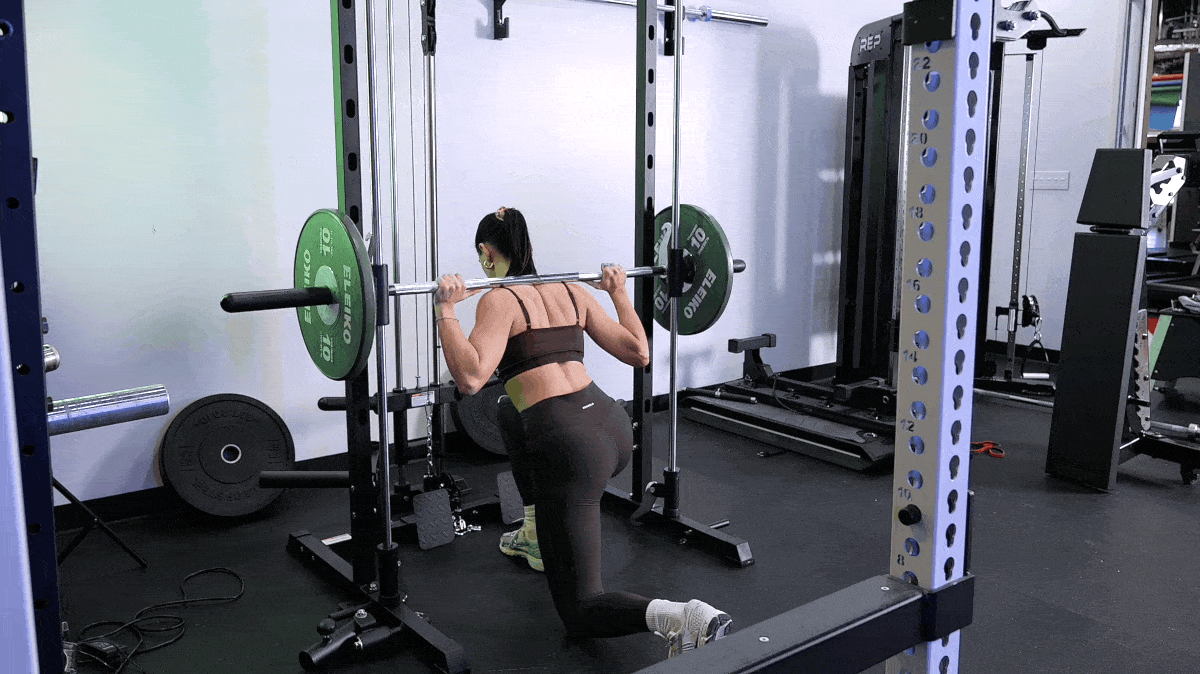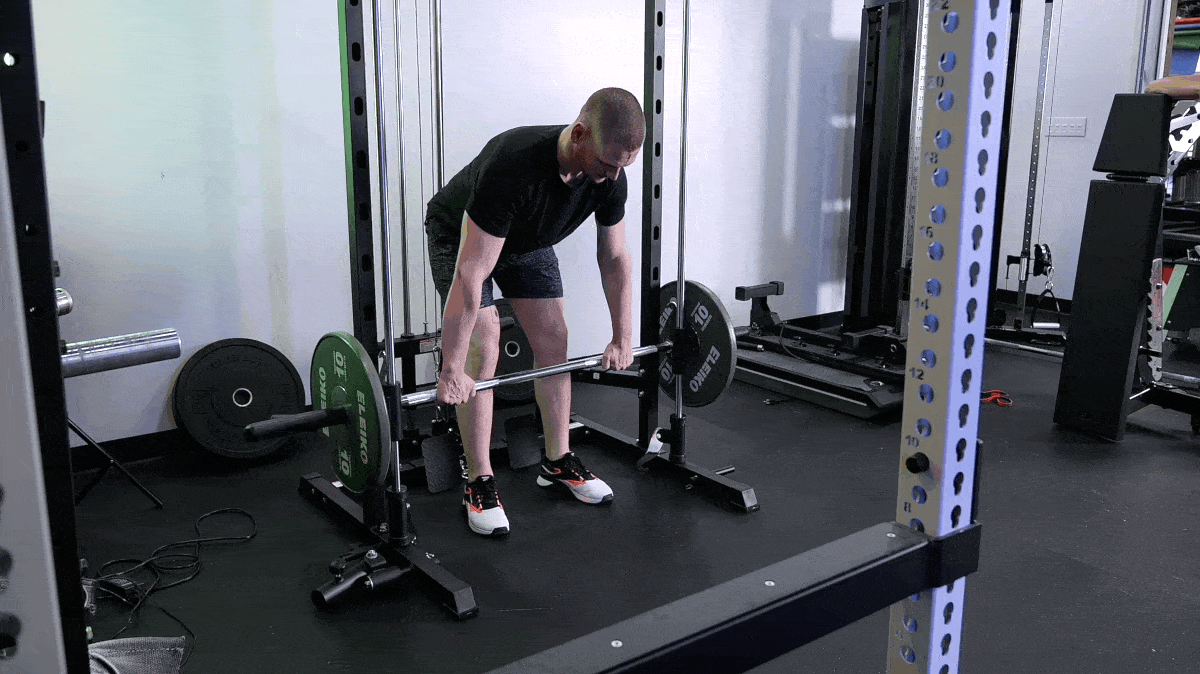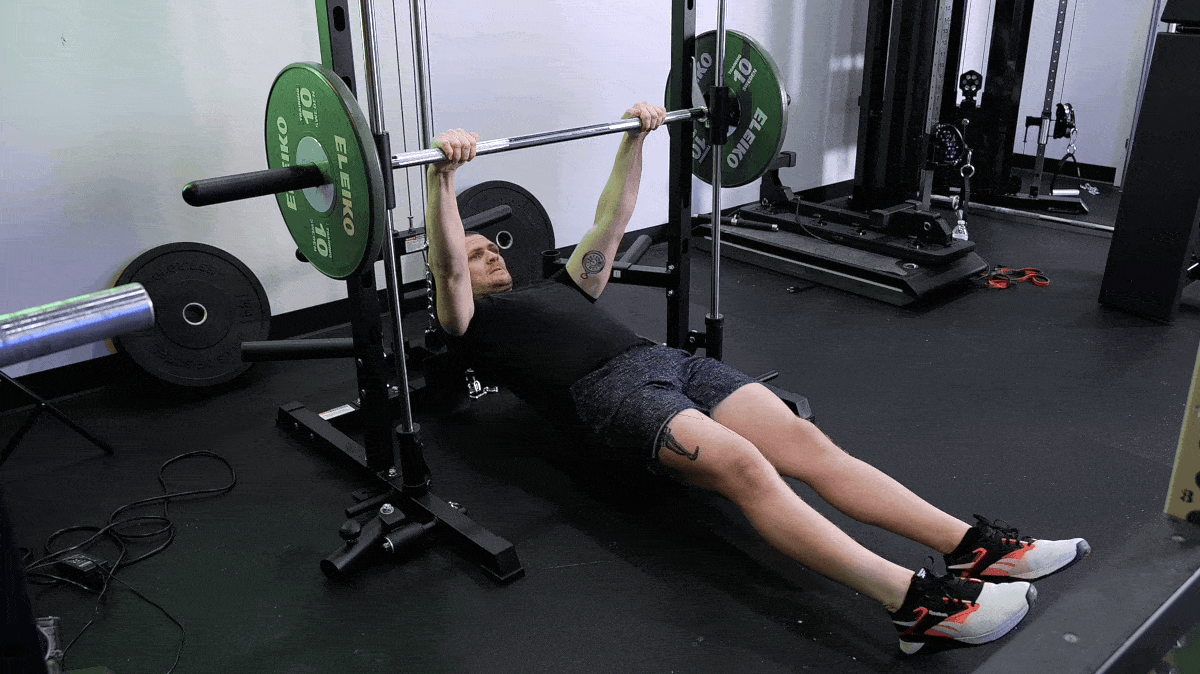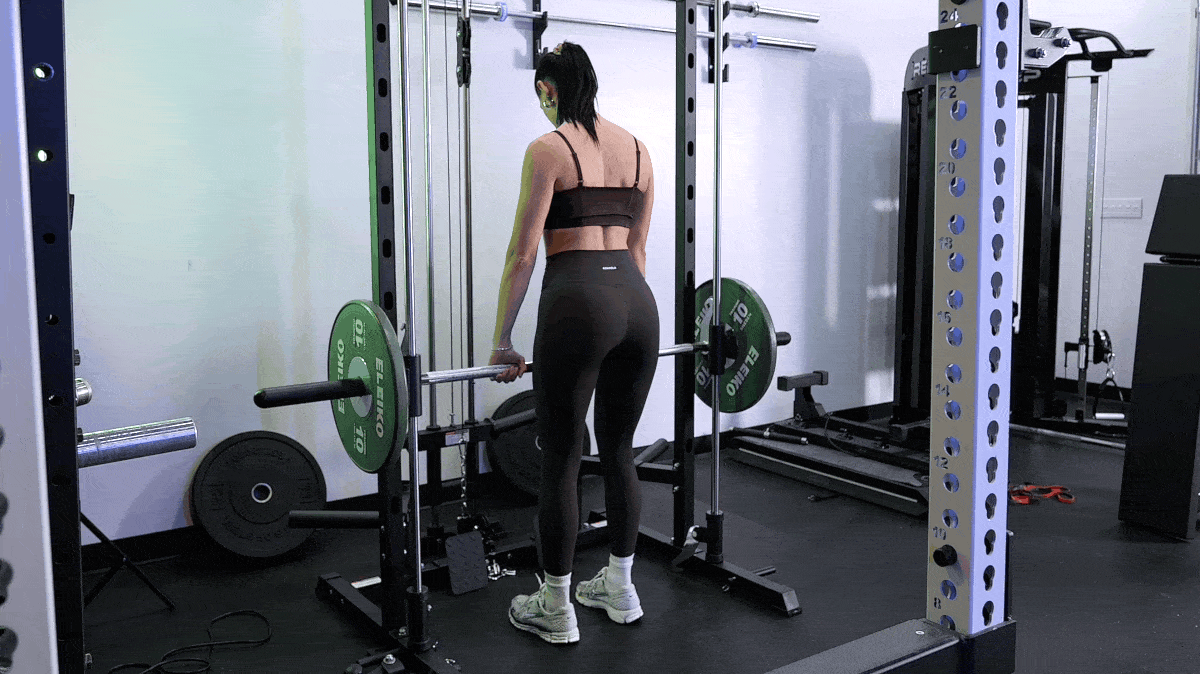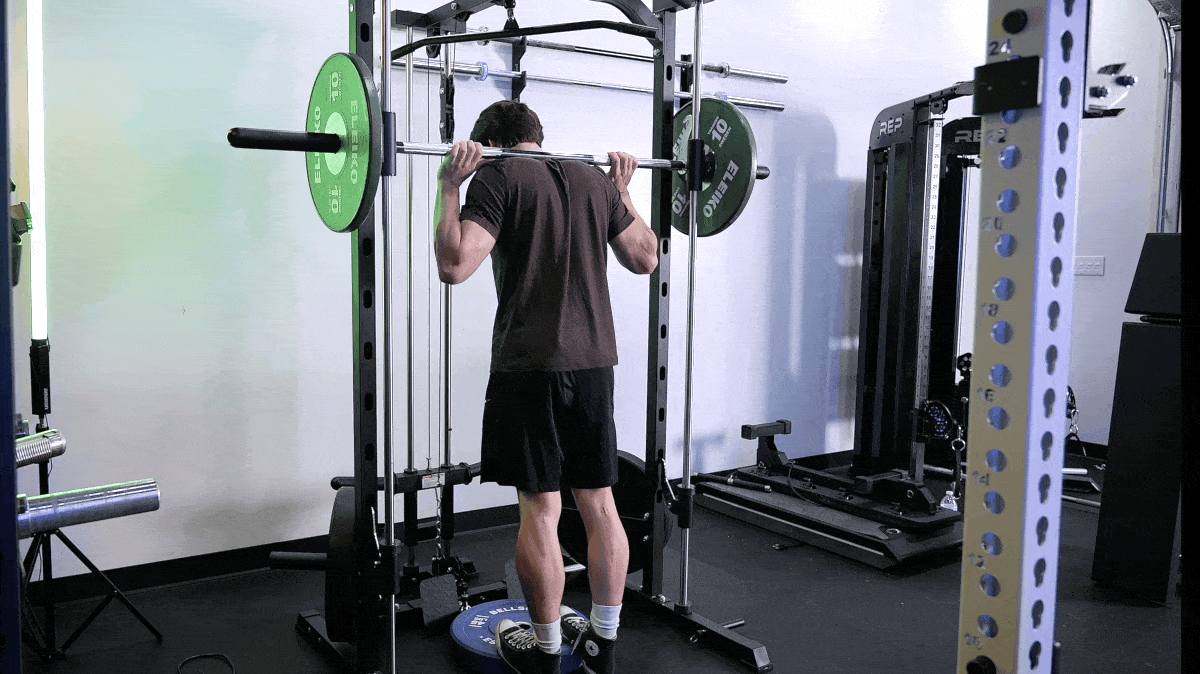The Smith machine may be one of the most reviled pieces of equipment in the gym — but if you’re a Smith machine troll, you may want to reconsider your position. There is a place for it in your strength-building regimen. The Smith machine is not just a thousand dollar coat rack (as it’s sometimes referred to). This piece of equipment allows for you to attempt heavy lifts without a spotter and keeps the barbell on a guided path — which is a disadvantage for some lifts but a plus for others.
Additionally, since most people discredit the Smith machine — named for its inventor, Rudy Smith— it’s more likely to be open than other areas, like the squat rack. Here, we’ll detail some of the best moves to do with the Smith machine and how to execute them properly.
15 Best Smith Machine Exercises
- Kaz Press
- Smith Machine Back Squat
- Smith Machine Split Squat
- Behind-the-Back Shrug
- Smith Machine Incline Bench Press
- Smith Machine Bent Over Row
- Inverted Row
- Smith Machine Seated Shoulder Press
- Smith Machine Hip Thrust
- Smith Machine Romanian Deadlift
- Smith Machine One-Arm Negative Bench Press
- Smith Machine Single-Leg Deadlift
- Smith Machine Reverse Lunge
- Smith Machine Front Squat
- Smith Machine Calf Raise
Editor’s Note: The content on BarBend is meant to be informative in nature, but it should not be taken as medical advice. When starting a new training regimen and/or diet, it is always a good idea to consult with a trusted medical professional. We are not a medical resource. The opinions and articles on this site are not intended for use as diagnosis, prevention, and/or treatment of health problems. They are not substitutes for consulting a qualified medical professional.
1. Kaz Press
You can argue with us, but you can’t argue with three-time World’s Strongest Man Bill “Kaz” Kazmaier. Kaz dominated the Strongman scene in the 1980s and at one time held the bench press world record at 661 pounds. Of course, bench pressing involves triceps strength — which he was able to build using a Smith machine exercise.
The Kaz press is a hybrid between a close-grip bench press and a tricep extension. By using the Smith machine, rather than free weights, you’re removing the instability factor and allowing for heavier weight to be used. This, in turn, helps develop the muscles needed to build up your bench press.
How to Do It
- Lie face-up on a bench under the barbell.
- Keeping your elbows close to your body, grab the bar at shoulder-width or a closer grip if desired.
- Unrack the bar at full extension and start the bar above your clavicles with arms extended.
- Lower the bar toward your chest by bending at the elbows and allowing some movement at the shoulders.
- Stop about three inches off your chest, then push back to the starting position.
Coach’s Tip: Control the eccentric to emphasize muscle growth.
Sets and Reps: Try 3 to 4 sets of 8 to 10 reps.
2. Smith Machine Back Squat
This is a controversial take, as many lifters and strength coaches heavily advise against doing squats outside of a more traditional squat rack. They reason that the machine’s fixed vertical path doesn’t allow for variability in movement, resulting in injury.
They’re not entirely wrong. That said, when done with proper form, a Smith machine squat can result in serious gains. A 2010 study in the Journal of Strength and Conditioning Research found free weight and Smith machine squats resulted in most muscles worked by the move, except for the gastrocnemius (calf muscle), biceps femoris (the back part of the thigh), and vastus medialis (the inner part of the quadriceps), which all responded better to free weights. (1)
A 2005 study in the same journal also found the Smith machine resulted in a heavier one-rep max than free weights in participants with limited weight training experience, partially due to a reduced need for balancing oneself during the move. (2)
The Smith machine squat is performed similar to a free weight one, except that your feet should be slightly in front of the barbell instead of directly underneath the bar. Additionally, ensure your knees don’t travel too far past your toe line — while this is OK to some extent, taking it to the extreme has been shown to be potentially detrimental to your joint health. (3)
How to Do It
- Stand at a shoulder-width stance with the bar across your shoulders and traps.
- Unlock the bar by lifting it up and forward.
- Bracing your core and keeping your head forward and spine in a neutral position, squat down until your thighs are parallel to the floor.
- Hold for a one count before coming back up.
Coach’s Tip: Keep even foot pressure throughout the movement. Don’t sit on your heels or pop up on your toes.
Sets and Reps: Go for 2 to 4 sets of 6 to 12 repetitions depending on your goal.
3. Smith Machine Split Squat
Like the squat, doing split squats with a Smith machine will ensure you have more stability during the movement. That stability allows you to lengthen your stride, which in turn allows for greater hip flexion and greater stretch of the gluteus maximus. Furthermore, it allows for greater training of your weaker leg to address muscle imbalances.
To create even more muscle extension, elevate your front or back foot on a block or bench. The Journal of Strength and Conditioning Research in 2017, however, did note that doing this move with a Smith machine does result in decreased muscle activation in the body’s frontal plane. (4)
How to Do It
- Get under the barbell so it’s resting on your traps, and then step back with one leg.
- With the bar on your back and traps, unlock the bar from the machine.
- Facing forward and keeping your spine neutral, descend until your back knee reaches the floor.
Coach’s Tip: Keep the vast majority of your body weight on your working leg.
Sets and Reps: Do 2 to 3 sets of 8 to 15 repetitions.
4. Behind-the-Back Shrug
This trap isolation move is great when done from the front, but when you grab the bar from behind you in a Smith machine, you’re able to move further away from the bar and move it up higher. This results in greater isolation of the traps, especially the middle of the traps responsible for shoulder stabilization.
How to Do It
- Place the bar at glute level and stand facing away from it.
- Grasp the bar slightly wider than shoulder-width with an overhand grip.
- Shrug the bar upwards and hold it for a one count before returning to the starting position.
Coach’s Tip: Narrow your grip if you have issues with the barbell bashing against your caboose.
Sets and Reps: Bang out 2 or 3 sets of 12 to 15 repetitions.
5. Smith Machine Incline Bench Press
Sensing a theme here? Instead of worrying about the bar dropping on top of your face or chest during an incline bench, all you have to do in a Smith machine is pop it back into the guides once you find yourself struggling.
The same study that found the Smith machine superior for building up a one-rep max on the squat found the opposite for bench pressing. A separate one, also in the Journal of Strength and Conditioning Research, noted free weights and machine benches resulted in similar muscle activation for all chest muscles except for the medial deltoid (the muscle that gives your shoulder its rounded look), which responded better to free weights. (5) The point is, use this variation more for muscle-building than to gain strength.
If your upper chest is your focus, though, the Smith machine incline press allows for heavier weights to be used without fear of injury. Similar to when using free weights, be sure not to bend your wrist on the ascent.
How to Do It
- Set a bench at a 45-degree angle.
- Using a closed grip, grab the bar slightly wider than shoulder-width apart.
- Raise the bar, unlock it, and lower it down to your chest while keeping your forearms vertical and making sure your elbows don’t flare out.
Coach’s Tip: Keep your elbows directly under the bar at all times.
Sets and Reps: Try 2 to 3 sets of 8 to 12 reps.
6. Smith Machine Bent Over Row
This move is a must for anyone looking to develop their back muscles, and with the Smith machine, you can go heavier than if you were using a barbell.
Doing it on a Smith machine takes your stabilizing muscles out of the equation due to the bar’s fixed path, which means your lats, rhomboids, and traps are better targeted than if you were doing it with a barbell.
How to Do It
- Lower the bar all the way down.
- Grab the bar with your hands slightly wider than shoulder-width apart and with an overhand grip.
- Keeping your back straight, bend slightly at the knees and pull the weight up to your body.
- Slowly lower it to your knees and repeat.
Coach’s Tip: Hinge until your torso is nearly parallel to the floor, but not perfectly.
Sets and Reps: Try to do 3 or 4 sets of 6 to 10 repetitions.
7. Inverted Row
While this is technically a bodyweight exercise, what makes it so great for the Smith machine is that you can adjust the bar to your preferred height. You can technically do this in a power rack, too, but it’s just plain easier with the Smith machine.
Plus, nobody wants to be the person who’s doing these in the squat rack with a line of angry gym-goers behind them.
How to Do It
- Set an empty bar around waist height.
- Lie on the floor face-up, and grab with an overhand grip, slightly wider than shoulder-width apart.
- Bracing your core, pull yourself up until your chest reaches the bar. Slowly lower yourself back down.
Coach’s Tip: Brace your core hard by tucking your pelvis slightly.
Sets and Reps: Reps are your friend. Do 2 to 4 sets of 12 to 25 repetitions if you aren’t adding extra weight to your body.
8. Smith Machine Seated Shoulder Press
The Smith machine seated shoulder press targets your anterior and medial deltoids. It will strengthen your posterior deltoids, too, as they help stabilize the weight in the proper position overhead. Since you’ll be sitting, you’re focusing solely on your upper body to move the weight.
The fixed bar path and the ability to change your range of motion makes the Smith machine seated overhead press potentially easier to learn. This is a solid variation if your shoulders disagree with regular overhead pressing.
How to Do It
- Set up the weight bench with the back support behind the bar. The bar needs enough room to pass in front of your face.
- Grip the bar using an overhand grip with your preferred grip width and unlatch the bar.
- Press straight up until lockout.
- Slowly lower to the starting position. Reset and repeat.
Coach’s Tip: Keep your elbows under the bar the whole time as you press.
Sets and Reps: Perform 3 to 4 sets of 6 to 10 repetitions.
9. Smith Machine Hip Thrust
The hip thrust will build both strength and mass in your glutes — and, to a lesser extent, your hamstrings. And if a Smith machine is more accessible to you than a freestanding barbell, you can perform your hip thrusts there.
The setup in the Smith machine is a little easier. Because you’re taking stabilization largely out of the equation, you can potentially go a lot heavier here. Targeting your glutes with extra weight can improve your deadlift lockout and squat strength, just like the regular barbell hip thrust.
How to Do It
- Set up a bench behind the bar.
- Put your upper back on the bench with the bar over your hip crease.
- Place your feet more than hip-width apart. Grip the bar using an overhand grip.
- Unlatch the bar by extending your hips.
- Fold at your hips to lower the bar toward the ground.
- When your glutes are near the floor, forcefully push the bar up to starting position.
Coach’s Tip: At the top, there should be a straight line from your shoulders to your kneecaps if viewed from the side.
Sets and Reps: Go for 3 to 4 sets of 8 to 12 repetitions.
10. Smith Machine Romanian Deadlift
The Smith machine Romanian deadlift is performed just like the barbell variation. You’ll lower the bar to about mid-shin level and then come back up. This keeps constant tension on the glutes and hamstrings, making it a more targeted option to strengthen those areas than the standard deadlift.
The Smith machine Romanian deadlift will help you load up heavier than your standard RDL. But, you’ll still be less heavy than a regular barbell deadlift, so you’ll be able to add lower body training volume pretty safely.
How to Do It
- Set the Smith machine bar at mid-shin level.
- Stand tall with your feet hip-distance apart.
- Hinge down and grip the bar with an overhand grip.
- With your chest up and shoulders down, brace your core. Drive through your legs.
- Use your hamstrings and glutes to pull you back to a standing position. Reset and repeat.
Coach’s Tip: Hinge down until the bar passes your knees. If you can go further, up the weight and dial in your form.
Sets and Reps: Try out 3 to 5 sets of 8 to 12 repetitions.
11. Smith Machine One-Arm Negative Bench Press
The eccentric portion of a lift refers to the part when the muscle is lengthening rather than contracting. That’s the upward portion of a triceps extension and the downward portion of a biceps curl and squat. In the eccentric phase of a lift, you’re typically stronger than you are when you’re contracting your muscle.
Because of this, you’ll often need a spotter when training heavy eccentrics, or negatives. But the Smith machine one-arm negative bench press can take away the need for a spotter. You lower the bar with one hand, and you lift with two. This will overload the chest and triceps and will help you iron out imbalances between sides.
How to Do It
- Set up as you would for your Smith press bench press. Grip the bar with both hands.
- Press up and unlatch the bar.
- Take one hand off when you reach lockout.
- With one arm, slowly lower the bar to your chest.
- Place the other hand back on the bar. Press up until lockout.
- Reset and repeat on the other arm.
Coach’s Tip: Allow your non-working arm to hang out to the side if you need more balance here.
Sets and Reps: Try 1 or 2 sets of 8 to 12 repetitions.
12. Smith Machine Single-Leg Deadlift
Along with the pistol squat, the single-leg RDL is difficult to perform well — but the benefits are many. You’ll improve your single-leg balance and reduce muscle imbalances. Both of these can help lead to fewer injuries.
You’ll also increase muscular hypertrophy and glute and hamstring endurance. The Smith machine single-leg deadlift increases the bar’s stability because of the straight bar path. This will reduce the complexity and make this difficult exercise easier to perform.
How to Do It
- Stand just behind the low bar.
- Hinge down and grip it with both hands.
- Lift one leg off the ground and bend your back knee.
- Using your glutes and hamstrings, hinge forward until you’re standing up straight.
Coach’s Tip: Keep your back leg relaxed; there’s no tension on those muscles in this exercise.
Sets and Reps: Try 2 or 3 sets of 8 to 12 repetitions.
13. Smith Machine Reverse Lunge
Reverse lunges are arguably the easiest of all the lunge variations. Doing them on the Smith machine will allow you to load this up for more muscle and strength.
Because you’re stepping back, the reverse lunge involves your hips. Because of this, you’ll put less stress on your knees than other lunge variations. As with most unilateral variations, the reverse lunge helps to decrease muscle imbalances and increase injury resilience.
How to Do It
- Stand tall with your feet hip-width apart.
- Duck under the bar. Secure it on your upper back. Unlatch the bar.
- Take either a small or large step back with your left foot. Lower your hips until your right thigh is parallel to the floor. Your right knee should be over your ankle.
- Keep your chest up and shoulders down. Push through your right foot and return to the starting position.
Coach’s Tip: Keep your gaze fixed on a single point in front of you to improve your balance.
Sets and Reps: Try 1 to 2 sets of up to 12 repetitions.
14. Smith Machine Front Squat
Regular barbell front squats are a great exercise for your quads, upper back, and core. But your upper back and core are usually the limiting factor — not your legs. The Smith machine front squat has an advantage because it helps ensure that your legs are the limiting factor.
That’s because your upper back and core are not working as hard to keep the bar in place. This is great if your goal is more mass on your legs.
How to Do It
- Set up the bar at upper chest height.
- Get underneath the bar in the front rack position.
- Take your preferred front squat grip. Unlatch the bar.
- Slowly lower down to your preferred squat depth.
- Push up through your heels to the starting position. Reset and repeat for reps.
Coach’s Tip: Keep your hands relaxed and ensure that your elbows stay pointed forward.
Sets and Reps: Try 3 or 4 sets of 5 to 8 reps.
15. Smith Machine Calf Raise
To strengthen and build your calves, you need exercises that provide a stretch at the bottom position. This provides a larger range of motion and the ability to add heavy loads. The Smith machine calf raise fits that bill.
When you use a secure platform to do the calf raises, that increased stability allows you to load more weight. This can ultimately lead to more calf muscle growth and strength.
How to Do It
- Stand on a stable raised surface. Set up the bar at shoulder height. Secure the bar on your upper back.
- Put the balls of your feet on the edge of the platform.
- Grip the bar with both hands using an overhand grip. Push up to unlatch the bar.
- Lower the bar until your feet are close to the ground. Push up through your toes, pausing at the top.
Coach’s Tip: Emphasize the eccentric, or lowering, portion of the movement.
Sets and Reps: Do 2 to 3 sets of 12 to 20 repetitions.
Smith Machine Warm Up
It is important to warm up with mobility and core work to get your muscles and joints ready for action. If you’re planning on going heavy with your Smith machine moves, it’s also important to add in ram-up sets as an extended warm-up after your mobility exercises. This way, your body will acclimate to the demands of heavier weights.
Ramp-up sets will grease the groove and help you determine your working weight for the day by how easy or hard a certain weight feels. They will also prep your body for heavy weights and give you extra volume at little cost.
Here’s an example of a ramp-up sets for Smith machine back squats:
- 10 reps with an empty barbell
- Eight reps with 105 pounds
- Six reps with 125 pounds
- Five reps with 155pounds
- Four rep with 175 pounds
This type of ramp-up set works well for most Smith machine exercises.
How To Train With the Smith Machine
The Smith machine is probably not the best tool to use for absolute strength. While you can go heavier on many exercises due to the increased machine stability, you typically want to build absolute strength while recruiting as many muscles as possible. That includes your stabilizers, which means you may want to use a barbell instead.
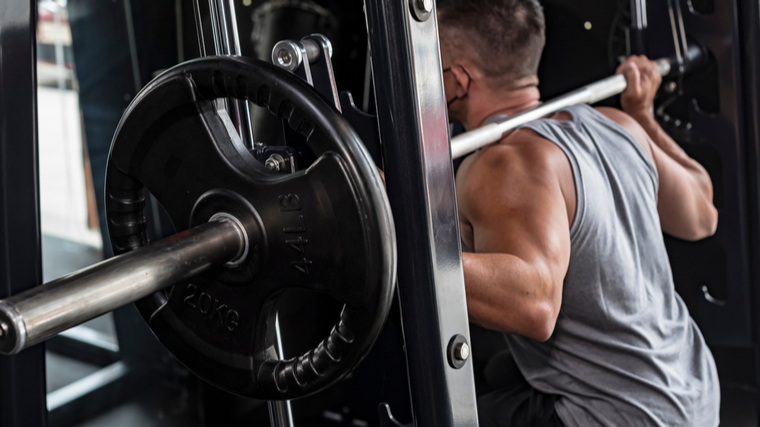
But when it’s time to bring up a lagging body part — which can ultimately serve the purpose of building absolute strength — definitely tap in the Smith machine. Because you don’t need to stabilize as much due to the fixed bar path, isolating the working muscle can lead to some serious gains.
Smith Machine Exercise Selection
The Smith machine isn’t as versatile as a standard barbell, primarily because the implement you’re lifting is locked into a fix plane of motion. This essentially means that you can only feasibly perform exercises that involve moving weight straight up or straight down. Luckily, most barbell exercises fall under this umbrella. If you want to perform moves like the front raise for your shoulders or any type of landmine exercise, though, you’ll have to look elsewhere.
Smith Machine Sets and Reps
The Smith machine is a training tool like any other. You get out what you put into it; this is true for both your exercises of choice and how you program them. Here’s a brief refresher on general set-rep prescriptions depending on your goals.
- To Gain Strength: Perform more overall sets, like 4 to 6, with low repetitions in the 3 to 7 range for most movements.
- To Build Muscle: Work with 2 to 4 sets of anywhere from 5 to 15 repetitions depending on the movement. Maintain good form and focus on really exhausting the target muscle, rather than simply throwing weight around.
- To Improve Endurance: Amp up your rep counts and reduce your rest times. Try 2 to 4 sets of 10 to 25 repetitions with a light weight and sub-90-second rest times if possible.
Smith Machine Training Tips
The Smith machine is easy to learn but difficult to master. If you want to get the most value out of your Smith machine exercises, you need to know how to utilize it to its full potential. Keep these tips in mind:
Don’t Fear Failure
The Smith machine is designed to provide two things: Safety and stability. You should have no problem stabilizing the bar’s movement, since most Smith machines are quite literally on rails. Further, Smiths come with easy-to-use safety hooks that you can deploy at a moment’s notice by twisting the bar to lock it back into the rack.
These safety measures afford you more breathing room when it comes to high-intensity training. You may not feel comfortable approaching a new 1-rep max or shooting for true failure with a free bar — totally understandable. The Smith should allay some of these fears and allow you to work very close to your limit with, comparatively, much less risk involved.
Adjust Your Technique (To a Degree)
When lifting free weights, your bar path will rarely move in a perfectly straight line. Put simply, the human body isn’t designed to operate with that much mechanical precision. For example, on the bench press, the bar begins directly over your shoulder joints and makes contact with your chest somewhere lower, often down by your sternum. The bar moves down and forward, and up and back.
This kind of motion is obviously incompatible with the Smith machine. Does this mean you can’t perform a bench press on the Smith? Not at all. You should, however, tweak your technique slightly, to make the movement as comfortable and ergonomic as you can.
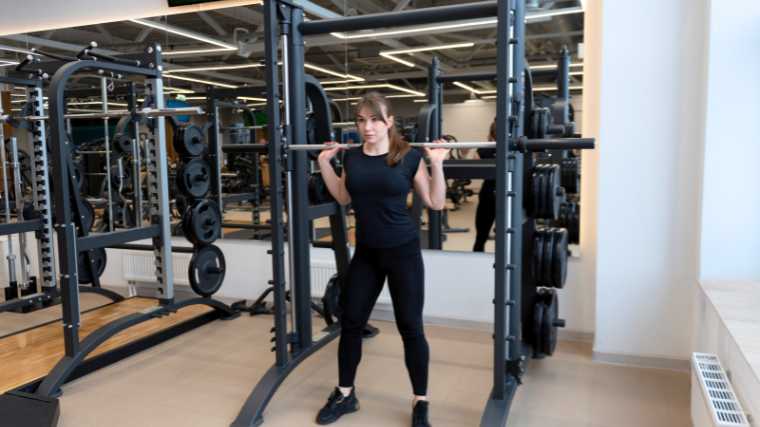
On the bench press, for instance, you may want to take a wider grip and flare your elbows out to the side a bit more so the bar doesn’t drift forward as you lower it down. This will apply a different kind of mechanical tension to your muscles and reduce the amount of awkwardness you may experience.
Benefits of the Smith Machine
The biggest knock on the Smith machine is its fixed plane of motion not being “functional.” And while most activities of daily living — and most compound lifts — don’t come with a fixed, pre-stabilized path, the Smith machine has some big advantages to offer. Some lifters see this machine as cheating, but its biggest con can be seen as its biggest strength.
The Smith machine’s fixed motion gives you the ability to load more weight — without needing a spotter. And when you can lift more safely on your own, you’re likely to be on the path to greater gains.
Great For Hypertrophy
The Smith machine’s fixed range of motion allows you to target a muscle more directly by taking stabilization out of the equation. For example, whenever you bench press, the bar needs to be set, with your feet and back firmly planted on the bench.
While you should still maintain proper form while benching on the Smith machine, you don’t need to worry about dropping a loaded barbell on your face. Plus, because you don’t have to work as hard to stabilize the weight, you can lift more on the Smith machine. This means that you can overload the target muscle with more weight than you can typically lift — leading to greater muscle growth.
Reduced Injury Risk
The fixed plane of motion of a Smith machine not only means you can lift more weight. It also means that you can perform exercises with consistent form. Especially for beginners, this can help reduce the risk of injury. Because of this, the Smith machine is a great way for a beginner to get used to barbell training.
Self-Spotting Machine
To use a Smith machine, you’ll turn the barbell towards you to unhook it. Perform your lift, then rotate the bar back to re-hook it. While pretty much everything in training comes with a bit of risk, using a Smith machine’s built-in protections and safety hooks is still a lot safer than trying to bench press a one-rep max with no spotter.
Final Word
While you may not want to build your entire program around Smith machine lifts, there’s no reason to knock them as a whole. Smith machine exercises can help target your weak points, isolate both big and small muscles for growth, and help beginners learn movement integrity. Plus, Smith machines are a much more accessible alternative for many lifters, perhaps especially in a crowded gym. So what are you waiting for? Get (Smith) lifting.
References
- Schwanbeck, Shane; Chilibeck, Philip D; Binsted, Gordon A Comparison of Free Weight Squat to Smith Machine Squat Using Electromyography, Journal of Strength and Conditioning Research: December 2009 – Volume 23 – Issue 9 – p 2588-2591 doi: 10.1519/JSC.0b013e3181b1b181
- Schick, Evan E; Coburn, Jared W; Brown, Lee E; Judelson, Daniel A; Khamoui, Andy V; Tran, Tai T; Uribe, Brandon P A Comparison of Muscle Activation Between a Smith Machine and Free Weight Bench Press, Journal of Strength and Conditioning Research: March 2010 – Volume 24 – Issue 3 – p 779-784 doi: 10.1519/JSC.0b013e3181cc2237
- Fry AC, Smith JC, Schilling BK. Effect of knee position on hip and knee torques during the barbell squat. J Strength Cond Res. 2003 Nov;17(4):629-33. doi: 10.1519/1533-4287(2003)017<0629:eokpoh>2.0.co;2. PMID: 14636100.
- McCurdy, Kevin PhD Technique, Variation, and Progression of the Rear-Foot-Elevated Split Squat, Strength and Conditioning Journal: December 2017 – Volume 39 – Issue 6 – p 93-97 doi: 10.1519/SSC.0000000000000319
- Schick EE, Coburn JW, Brown LE, Judelson DA, Khamoui AV, Tran TT, Uribe BP. A comparison of muscle activation between a Smith machine and free weight bench press. J Strength Cond Res. 2010 Mar;24(3):779-84. doi: 10.1519/JSC.0b013e3181cc2237. Erratum in: J Strength Cond Res. 2011 Jan;25(1):286. PMID: 20093960.
Featured Image: MDV Edwards / Shutterstock


